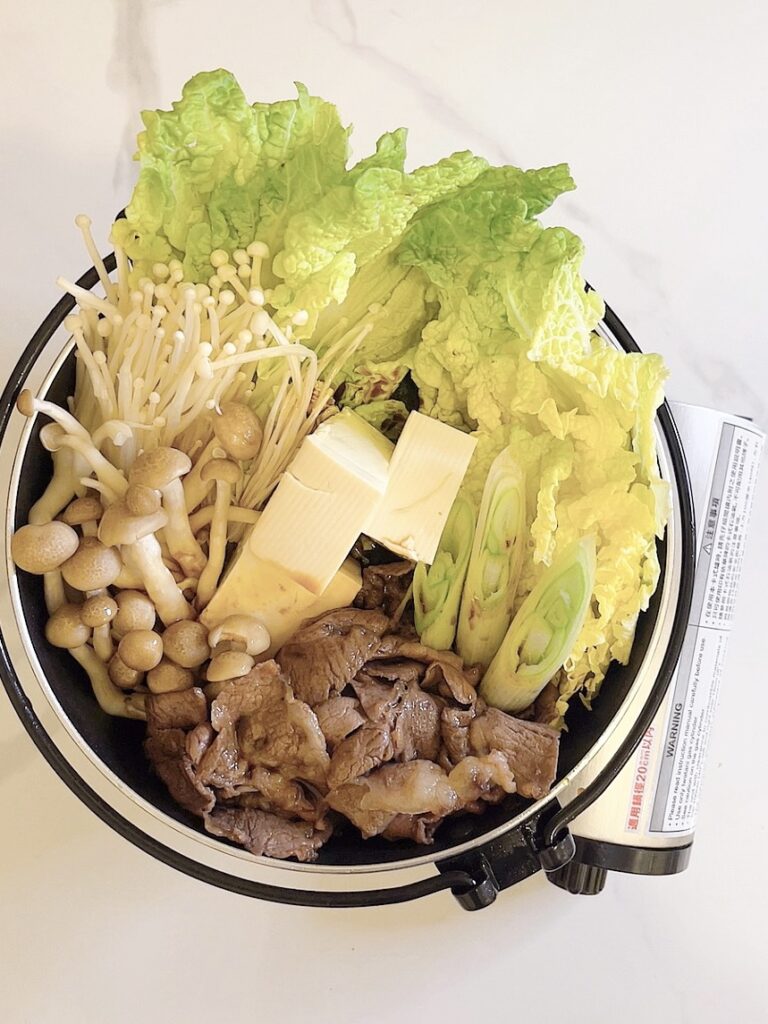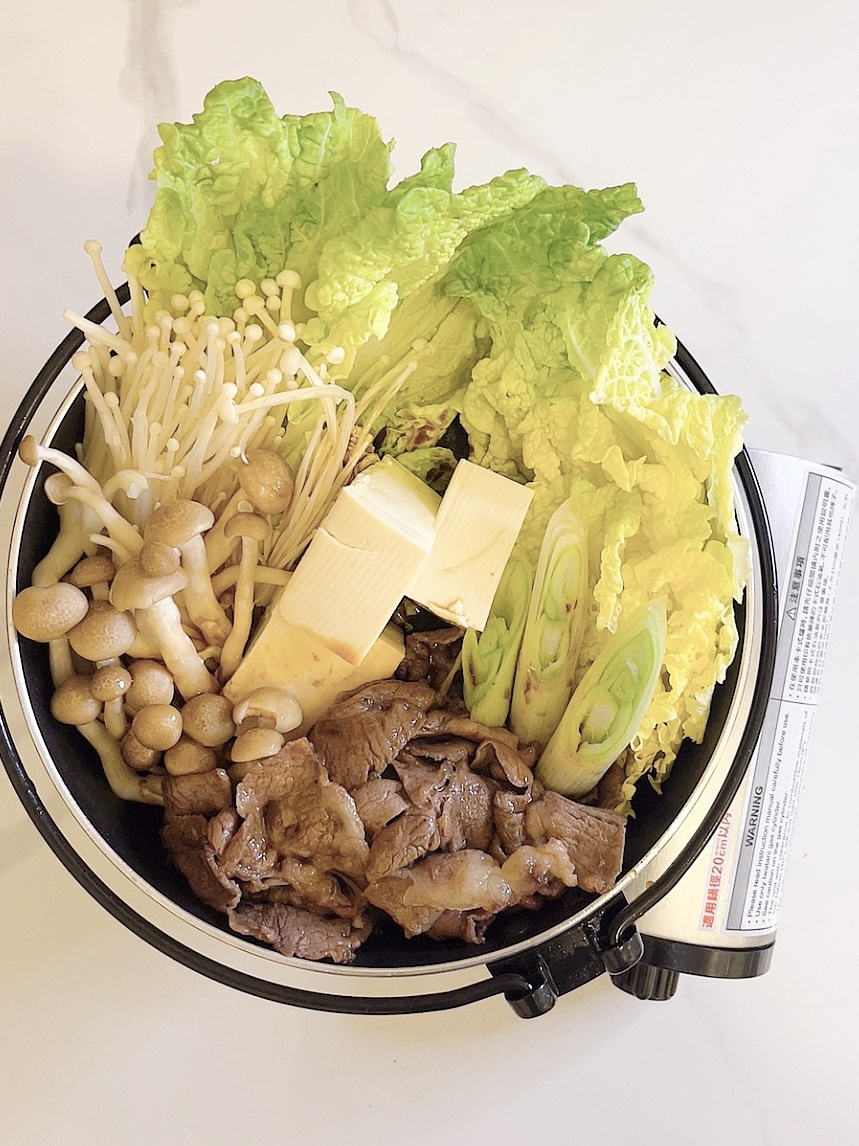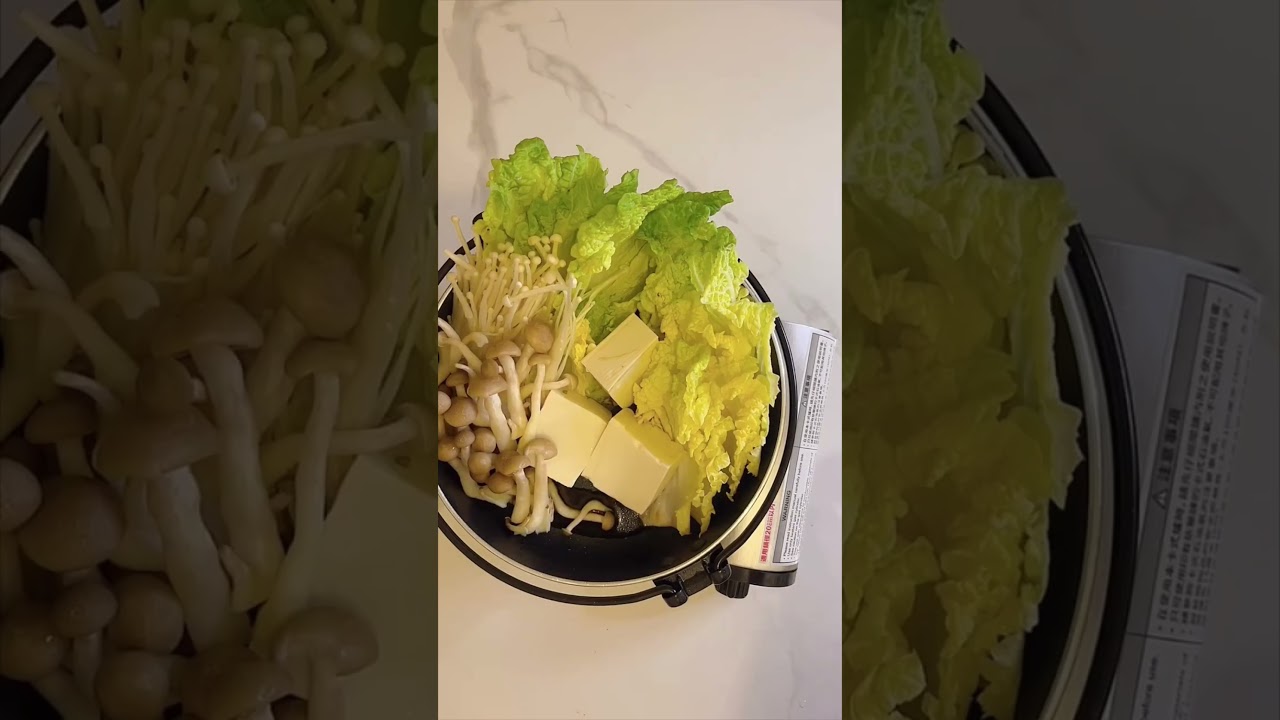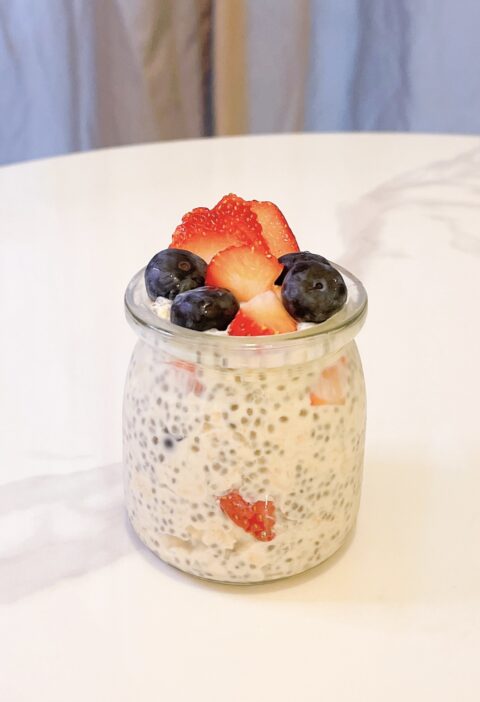What is Sukiyaki?
Sukiyaki is a popular Japanese hot pot dish known for its rich and savory flavor. It typically consists of thinly sliced beef, tofu, and a variety of vegetables simmered together in a sweet and savory soy-based broth. The ingredients are cooked at the table in a shallow, wide pot or skillet, and diners often dip the cooked ingredients into beaten raw egg before eating. Sukiyaki is not only a delicious and hearty meal but also a communal dining experience!
Key components of sukiyaki include:
- Thinly Sliced Beef: High-quality beef, such as thinly sliced ribeye or sirloin, is a central ingredient in sukiyaki. The beef is marbled and tender, contributing to the dish’s rich flavor.
- Tofu: Sukiyaki typically includes tofu, which absorbs the flavors of the broth and adds a creamy texture to the dish.
- Vegetables: A variety of vegetables are added, such as napa cabbage, mushrooms (shiitake and enoki are common choices), scallions, and sometimes other ingredients like shirataki noodles.
- Broth: The broth is made with a combination of soy sauce, sugar, and mirin (a sweet rice wine). It’s a sweet and savory sauce that infuses all the ingredients with a delicious taste.
- Dipping Sauce: After the ingredients are cooked, they are often dipped into a beaten raw egg before being eaten. This adds a creamy, velvety texture to the dish and enhances its flavor.
Sukiyaki is enjoyed year-round but is especially popular in the colder months, as it provides warmth and comfort. It’s a well-loved part of Japanese cuisine and can be found in restaurants or made at home for special occasions and family gatherings.
What are the Ingredients to Make Sukiyaki?
The ingredients for making sukiyaki typically include:
- Thinly Sliced Beef: High-quality beef, such as ribeye or sirloin, is the primary protein component. It’s typically sliced very thinly.
- Tofu: Sukiyaki often includes tofu, which can be cut into cubes and added to the hot pot for a creamy texture.
- Vegetables: A variety of vegetables are used, and common choices include napa cabbage, shiitake mushrooms, enoki mushrooms, scallions, and sometimes other vegetables like carrots or leafy greens.
- Shirataki Noodles: These are translucent, gelatinous noodles made from konjac yam, and they are sometimes added to the hot pot for texture.
- Broth: The broth is made from a combination of soy sauce, sugar, and mirin (a sweet rice wine). This mixture forms a sweet and savory sauce that seasons and cooks the ingredients.
- Raw Eggs: Diners often beat raw eggs in a small bowl and use them as a dipping sauce for the cooked ingredients. The hot ingredients are dipped into the egg before eating, adding a creamy and rich texture.
Sukiyaki is a customizable dish, and the choice of vegetables can vary based on personal preferences and seasonal availability. The key is to create a harmonious combination of savory, sweet, and umami flavors in the broth. It’s a warm and hearty meal, perfect for enjoying with family and friends around a shared table.
How to Make Sukiyaki?
Instructions:
- Prepare Ingredients:
- Cut all the ingredients into bite-sized pieces for easy cooking and eating.
- Drain and rinse the shirataki noodles if using.
- Mix Sukiyaki Sauce:
- In a bowl, mix together soy sauce, sugar, mirin, sake, and 1-2 cups of dashi stock (adjust to your preference for sweetness and saltiness). This mixture will be your sukiyaki sauce.
- Heat the Pan:
- Heat a large, shallow skillet or sukiyaki pan over medium-high heat. Grease the pan with a little cooking oil.
- Cook Beef:
- Place a few slices of beef in the skillet and cook briefly until browned but not fully cooked. Remove the beef and set it aside.
- Add Ingredients:
- Add tofu, shiitake mushrooms, napa cabbage, shungiku or spinach, scallions, and enoki mushrooms to the pan. Arrange them neatly, keeping each ingredient separate.
- Pour Sukiyaki Sauce:
- Pour the sukiyaki sauce over the ingredients in the pan.
- Cook and Simmer:
- Cover the pan and let the ingredients simmer for a few minutes until they are cooked and tender.
- Dip in Raw Egg:
- To eat, take a piece of cooked ingredient and dip it into a bowl of beaten raw egg. The egg adds a creamy texture and extra flavor.
- Enjoy:
- Continue cooking and eating, adding more ingredients to the pan as you go.
- Refill Sukiyaki Sauce:
- If the sukiyaki sauce in the pan reduces too much, you can refill it with more sauce or dashi stock.
- Finish:
- When all the ingredients are cooked and eaten, you can finish the meal with noodles (such as udon or shirataki noodles) cooked in the remaining broth.
Sukiyaki is a fun and interactive meal that’s perfect for gatherings. Enjoy it hot, straight from the pan, and customize it with your favorite ingredients and seasoning.
How to Make a Healthy Sukiyaki Hot Pot?
You can make a healthier version of sukiyaki by making some modifications to the traditional recipe. Here are some tips to create a healthier sukiyaki:
- Leaner Protein: Choose lean cuts of beef or even substitute beef with chicken, turkey, or seafood to reduce the overall fat content.
- Less Sugar: Use less sugar or a natural sweetener like honey or maple syrup to reduce the sweetness in the broth.
- Reduced Sodium: Opt for low-sodium soy sauce or use a reduced-sodium soy sauce to lower the overall salt content.
- More Vegetables: Increase the vegetable-to-meat ratio. Load up on a variety of vegetables like mushrooms, leafy greens, bell peppers, and carrots to add fiber and vitamins.
- Whole Grains: Add some whole grains like brown rice, quinoa, or noodles made from whole wheat or other nutritious ingredients for added fiber.
- Healthier Dipping Sauce: Consider using a low-fat yogurt-based dipping sauce instead of raw eggs for a healthier option.
- Less Oil: Use cooking spray or a small amount of oil for stir-frying the ingredients to cut back on excess fat.
- Portion Control: Be mindful of portion sizes to avoid overeating, as sukiyaki can be quite filling.
- Tofu Variations: Use firm or silken tofu as a protein source instead of or in addition to meat. Tofu is lower in fat and calories.
- Broth Adjustments: Experiment with making the broth with a reduced-sodium or no-sodium vegetable or chicken broth and season it with a smaller amount of soy sauce and natural sweeteners.
By making these adjustments, you can enjoy a lighter and healthier version of sukiyaki that still maintains the essence of the dish’s delicious flavors while reducing its overall fat and sugar content.
Best Way to Serve Sukiyaki Hot Pot
Serving sukiyaki hot pot is all about creating an inviting and communal dining experience. Here’s the best way to serve sukiyaki:
- Use a Sukiyaki Pot: Invest in a traditional sukiyaki pot or a wide, shallow, electric hot pot that can be placed on the dining table. These pots are ideal for cooking and serving sukiyaki at the table.
- Prepare Ingredients: Have all the sukiyaki ingredients (beef, tofu, vegetables, noodles, etc.) prepped and ready to go. Arrange them neatly on platters or in individual dishes for easy access.
- Set the Table: Place the sukiyaki pot in the center of the dining table. You can also use a portable stove if you don’t have an electric sukiyaki pot. Ensure each guest has their own bowl for dipping sauce and a pair of chopsticks.
- Heat the Pot: If using an electric pot, preheat it according to the manufacturer’s instructions. If using a portable stove, have it ready to heat the pot at the table.
- Add Ingredients: Start adding ingredients to the pot. Begin with a small amount of sukiyaki sauce at the bottom, followed by slices of beef, tofu, and vegetables. Add more sauce as needed.
- Simmer and Serve: Let the ingredients simmer and cook in the pot. As they become tender, you and your guests can begin to serve themselves, dipping the cooked ingredients into a bowl of beaten raw egg.
- Replenish Ingredients: Continue adding more ingredients to the pot as the meal progresses, replenishing the sauce as needed. This allows for a steady stream of fresh and hot ingredients.
- Noodles at the End: Towards the end of the meal, add noodles (such as udon or shirataki) to the pot to cook in the flavorful broth.
- Garnishes: Provide condiments like sesame seeds, chopped scallions, or grated daikon radish as garnishes. These can be added to the dipping sauce or sprinkled on top of the ingredients.
- Dipping Sauce: Each guest should have a small bowl with a raw egg for dipping the cooked ingredients. Encourage them to customize their dipping sauce with condiments and spices to taste.
- Enjoy the Experience: Sukiyaki is not just about the food but also the interactive experience. Enjoy the meal while conversing and cooking together.
Serving sukiyaki this way ensures that the ingredients stay hot and fresh, and it allows your guests to customize their meal to their liking. The communal aspect of cooking and dining together makes it a memorable and enjoyable experience.

Healthy Sukiyaki Recipe (Japanese Beef Hot Pot)
Description
Here’s a detailed and healthier version of a sukiyaki recipe. This recipe focuses on using leaner ingredients and reducing the sugar and sodium content:
Ingredients
Instructions
- Prepare Ingredients:
Cut all the ingredients into bite-sized pieces. - Mix Sukiyaki Sauce:
In a bowl, combine low-sodium soy sauce, sugar, reduced-sugar mirin, reduced-sodium sake, and 1-2 cups of reduced-sodium dashi stock. Adjust the sweetness and saltiness to your preference. - Heat the Pan:
Heat a large, shallow skillet or sukiyaki pan over medium-high heat. You can use cooking spray or a minimal amount of cooking oil to grease the pan. - Cook Beef:
Place a few slices of lean beef in the skillet and cook briefly until browned but not fully cooked. Remove the beef and set it aside. - Add Ingredients:
Add tofu, shiitake mushrooms, napa cabbage, spinach or chard, scallions, and enoki mushrooms to the pan. Arrange them neatly, keeping each ingredient separate. - Pour Sukiyaki Sauce:
Pour the sukiyaki sauce over the ingredients in the pan. - Cook and Simmer:
Cover the pan and let the ingredients simmer for a few minutes until they are cooked and tender. - Dip in Raw Egg:
To eat, take a piece of cooked ingredient and dip it into a bowl of beaten raw egg. The egg adds a creamy texture and extra flavor. - Enjoy:
Continue cooking and eating, adding more ingredients to the pan as you go. - Refill Sukiyaki Sauce:
If the sukiyaki sauce in the pan reduces too much, you can refill it with more sauce or dashi stock. - Finish:
When all the ingredients are cooked and eaten, you can finish the meal with noodles (such as udon or shirataki noodles) cooked in the remaining broth.
Notes
- This healthier sukiyaki recipe provides a lighter and more nutritious version of the traditional dish while preserving its delicious flavors and interactive dining experience.







